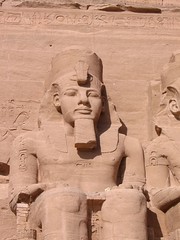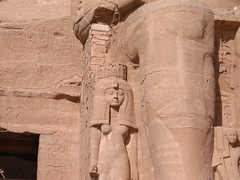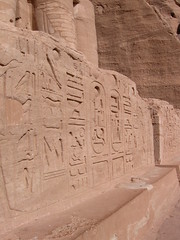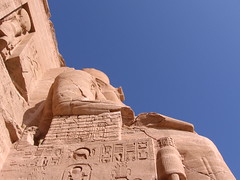
The four huge statues of Ramses himself stare out over Lake Nasser

and there are small carvings of his children around his feet - different ones by each colossus:


There are plenty of hieroglyphs carved on almost every surface.

The entryway lies between the two center Ramseses, and as you enter you notice you're about the size of a bug compared to him:

Inside, the hypostyle hall doesn't just have pillars: it has statues of Ramses! (This was apparently a good time to be a stonemason.) The huge tall walls are covered with huge tall relief carvings. There's lots more smiting, and a magnificent battle scene showing Ramses in his chariot shooting arrows at some folks who are probably Hittites. I love the way they carved the horses' legs kind of "fanning out", and the way Ramses's bow and arrow-arm are shown at two angles, as if at two different moments of time.
Another wall has the text of a great treaty between Ramses and the Hittite king following the Battle of Kadesh. (Click here and scroll down until you see the words "The Historic Treaty".
Further inside the temple you see storerooms that would have held offerings for the gods. In case someone forgot to bring the actual offerings, there were pictures (reliefs, really) of offerings as backup.
Way in the back of the temple is the Holy of Holies, containing four statues of gods that are one of Abu Simbel's claims to fame. It's not that these statues are spectacular looking. It's that the entire temple is oriented in such a way that on twice a year in October and February, the dawn sunlight shines right down the axis of the temple to shine on these statues. To be precise, it shines on three of the statues. The fourth, that of Ptah the god of darkness, remains in shadow.
Okay, that's cool enough. However it gets better. When the Egyptians built the Aswan High Dam, the rising floodwaters would have covered the temple with water. To prevent this, UNESCO sent a team to disassemble both entire temples, number all the pieces, and reassemble them at a higher elevation. They even built an artificial concrete dome to set them into, to mimic the original cliff they were carved in.

No comments:
Post a Comment